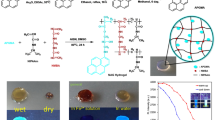Abstract
Poly (ethylene glycol)-co-( L -Lactic acid) diacrylate (PEG-PLLA-DA) copolymers have been extensively investigated for a number of applications in medicine. PEG-PLLA-DA is biodegradable and the human body can process its degradation products. In this study, we describe the autofluorescence of PEG-PLLA-DA copolymers and compared it to the fluorescence of poly(ethylene glycol) diacrylate (PEG-DA) and the precursor molecules used for their synthesis. In addition, we examined the influence of pH on the fluorescence spectra. We found that PEG-PLLA-DA exhibits higher fluorescence than PEG-DA and all reagents involved in the synthesis of PEG-PLLA-DA. The fluorescence of PEG-PLLA-DA was affected by pH with fluorescence decreasing at high pH values. At high pH, PEG-PLLA-DA could not polymerize into hydrogels and exhibited a dramatic decrease in autofluorescence, suggesting that hydrolysis of the ester bond affected its autofluorescence. At low pH, PEG-PLLA-DA exhibited higher fluorescence and it was able to form crosslinked hydrogels. The autofluorescence of PEG-PLLA-DA could be exploited to monitor polymer degradation and material structure without the need to introduce exogenous fluorescent probes. The origin of fluorescence is not clear at this point in time but it appears to result from a synergetic effect of both lactate units and diacrylate groups in the PEG-PLLA-DA backbone. The observed autofluorescence of PEG-PLLA-DA persists after reaction of the acrylate groups in the polymerization reaction. This autofluorescence is advantageous because it could assist in the study of polymers used for drug delivery and tissue engineering applications.







Similar content being viewed by others
References
Graham NB, Zulfiqar M, Nwachuku NE, Rashid A (1990) Interaction of poly(Ethylene Oxide) with solvents.4. Interaction of water with poly(Ethylene Oxide) cross-linked hydrogels. Polymer 31(5):909–916
Chiu YC, Cheng MH, Engel H, Kao SW, Larson JC, Gupta S, Brey EM (2011) The role of pore size on vascularization and tissue remodeling in PEG hydrogel. Biomaterials
Sawhney AS, Pathak CP, Hubbell JA (1993) Bioerodible hydrogels based on photopolymerized poly(ethylene glycol)-co-poly(a-hydroxy acid) diacrylate macromers. Macromolecules 26(4):581–587
Sawhney AS, Hubbell JA (1990) Rapidly degraded terpolymers of dl-lactide, glycolide, and e-caprolactone with increased hydrophilicity by copolymerization with polyethers. J Biomed Mater Res 24(10):1397–1411
Han DK, Hubbell JA (1997) Synthesis of polymer network scaffolds from L-Lactide and poly(ethylene glycol) and their interaction with cells. Macromolecules 30(20):6077–6083
Peppas NA, Bures P, Leobandung W, Ichikawa H (2000) Hydrogels in pharmaceutical formulations. Eur J Pharm Biopharm 50(1):27–46
Hattori K, Tomita N, Yoshikawa T, Takakura Y (2001) Prospects for bone fixation - development of new cerclage fixation techniques. Mat Sci Eng C-Bio S 17(1–2):27–32
Chu CR, Coutts RD, Yoshioka M, Harwood FL, Monosov AZ, Amiel D (1995) Articular cartilage repair using allogeneic perichondrocyteseeded biodegradable porous polylactic acid (PLA): a tissue-engineering study. J Biomed Mater Res 29(9):1147–1154. doi:10.1002/jbm.820290915
Feng SS, Ruan G, Li QT (2004) Fabrication and characterizations of a novel drug delivery device liposomes-in-microsphere (LIM). Biomaterials 25(21):5181–5189. doi:10.1016/J.Biomaterials.2003.12.013
Rounds RM, Ibey BL, Beier HT, Pishko MV, Cote GL (2007) Microporated PEG spheres for fluorescent analyte detection. J Fluoresc 17(1):57–63. doi:10.1007/S10895-006-0143-3
Kloxin AM, Kloxin CJ, Bowman CN, Anseth KS (2010) Mechanical properties of cellularly responsive hydrogels and their experimental determination. Adv Mater 22(31):3484–3494. doi:10.1002/Adma.200904179
Nagahama K, Fujiura K, Enami S, Ouchi T, Ohya Y (2008) Irreversible temperature-responsive formation of high-strength hydrogel from an enantiomeric mixture of starburst triblock copolymers consisting of 8-arm PEG and PLLA or PDLA. J Polym Sci Pol Chem 46(18):6317–6332. doi:10.1002/Pola.22943
Vermonden T, Jena SS, Barriet D, Censi R, van der Gucht J, Hennink WE, Siegel RA (2010) Macromolecular diffusion in self-assembling biodegradable thermosensitive hydrogels. Macromolecules 43(2):782–789. doi:10.1021/Ma902186e
Chiu YC, Larson JC, Perez-Luna VH, Brey EA (2009) Formation of microchannels in Poly(ethylene glycol) hydrogels by selective degradation of patterned microstructures. Chem Mater 21(8):1677–1682. doi:10.1021/Cm803520j
Chiu YC, Larson JC, Isom A, Brey EM (2010) Generation of porous poly(Ethylene Glycol) hydrogels by salt leaching. Tissue Eng Part C-Me 16(5):905–912. doi:10.1089/Ten.Tec.2009.0646
Metters AT, Bowman CN, Anseth KS (2000) A statistical kinetic model for the bulk degradation of PLA-b-PEG-b-PLA hydrogel networks. J Phys Chem B 104(30):7043–7049. doi:10.1021/jp000523t
Acknowledgments
This research was supported by funding from Veterans Administration.
Author information
Authors and Affiliations
Corresponding author
Rights and permissions
About this article
Cite this article
Chiu, YC., Brey, E.M. & Pérez-Luna, V.H. A Study of the Intrinsic Autofluorescence of Poly (ethylene glycol)-co-( L -Lactic acid) Diacrylate. J Fluoresc 22, 907–913 (2012). https://doi.org/10.1007/s10895-011-1029-6
Received:
Accepted:
Published:
Issue Date:
DOI: https://doi.org/10.1007/s10895-011-1029-6




